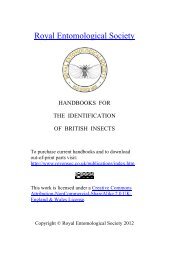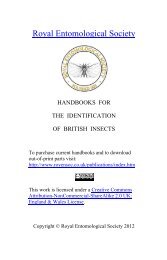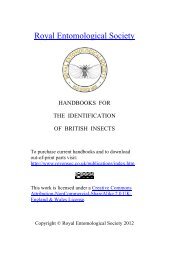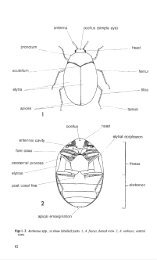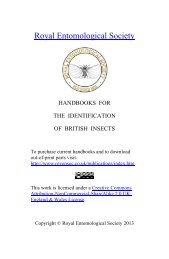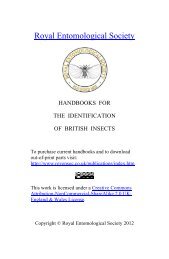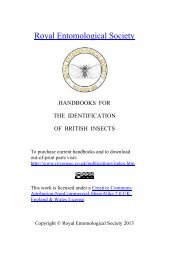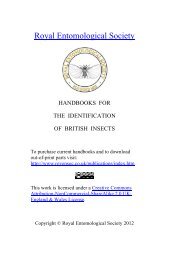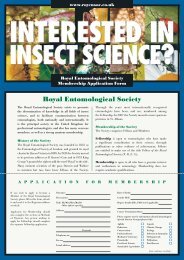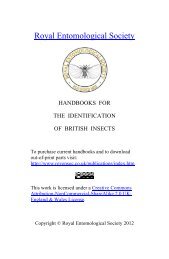Vol 10 Part 14. An introduction to the immature stages of British Flies ...
Vol 10 Part 14. An introduction to the immature stages of British Flies ...
Vol 10 Part 14. An introduction to the immature stages of British Flies ...
Create successful ePaper yourself
Turn your PDF publications into a flip-book with our unique Google optimized e-Paper software.
doubt many more cases occur than are diagnosed and recorded. Where myiasis is a<br />
normal way <strong>of</strong> life for fly larvae in animals this is described under <strong>the</strong> particular Diptera<br />
family concerned. The types <strong>of</strong> myiasis can be fur<strong>the</strong>r classified as follows.<br />
1. Blood-sucking maggots. E.g. Calliphoridae (Auchmeromyia senegalensis<br />
Macquart( = luteola Fabricius), <strong>the</strong> Congo floor-maggot (Afro-tropical)); Tabanidae<br />
(in paddy fields in Japan); Therevidae (fig. 161, Smith, 1979a, 1986a, <strong>British</strong> cases);<br />
Pro<strong>to</strong>calliphora on birds.<br />
2. Dermal and subdermal myiasis. Larvae penetrate unbroken skin or enter wounds<br />
or form boils or o<strong>the</strong>r lesions, ei<strong>the</strong>r at <strong>the</strong> site <strong>of</strong> entry or elsewhere, e.g. Calliphoridae,<br />
Gasterophilidae, Hypodermatidae, Muscidae and Sarcophagidae.<br />
Oldroyd (1964) reports 'I have known a female Sarcophaga <strong>to</strong> fly <strong>to</strong> a coat, <strong>the</strong> sleeve<br />
<strong>of</strong> which had been soiled with blood from a shot pheasant and immediately lay a batch<br />
<strong>of</strong> young larvae upon it'. Lucilia sericata (Meigen), a common green bottle, is also <strong>the</strong><br />
sheep maggot fly (fig. 809), <strong>the</strong> causal agent <strong>of</strong> sheep strike. Larvae <strong>of</strong> Lucilia and<br />
Calliphora may occur in cases <strong>of</strong> wound myiasis in man and animals. Calliphorid larvae<br />
(Lucilia sericata, L. caesar (Linnaeus) and Phormia regina (Meigen) have been used<br />
<strong>to</strong> clean wounds <strong>of</strong> necrotic tissue on <strong>the</strong> battlefield (Hinman, 1933, Imms, 1939,<br />
Greenberg, 1973) and may even exude an antibiotic (Pavillard & Wright, 1957). Osteomyelitis<br />
and o<strong>the</strong>r kinds <strong>of</strong> non-healing wounds have also been treated in this manner,<br />
e.g. heat burns, X-ray burns, varicose and diabetic ulcers, etc. (see also below under<br />
Musca domestica).<br />
First ins tar larvae <strong>of</strong> Gasterophilus can cause a creeping myiasis in man, usually on<br />
<strong>the</strong> face and but<strong>to</strong>cks (Zumpt, 1965) but I know <strong>of</strong> no <strong>British</strong> cases. Hypoderma<br />
may also be incriminated in this category (Smart, 1939) but is usually involved in<br />
nasopharyngeal myiasis (see below).<br />
Musca domestica larvae may occur in cases <strong>of</strong> human myiasis where urine is<br />
involved: e.g. in neglected cots or napkins <strong>of</strong> infants (Mumford, 1926, Chapman, R. K.,<br />
1944); in <strong>the</strong> feet and footwear <strong>of</strong> incontinent geriatric patients (see also urogenital<br />
myiasis). M . domestica has also been used <strong>to</strong> clean gangrenous wounds as <strong>the</strong> larvae do<br />
not attack healthy tissue (as o<strong>the</strong>r genera will- see above). Healing can commence<br />
48 hours after treatment begins (Imms, 1939).<br />
3. Nasopharyngeal myiasis. This includes invasion <strong>of</strong> <strong>the</strong> nasal fossae, frontal<br />
sinuses, pharyngeal cavities, eyeballs, eye-sockets and (aural myiasis) ears, e.g. Calliphoridae,<br />
Cuterebridae (non-<strong>British</strong>), Gasterophilidae, Hypodermatidae, Myce<strong>to</strong>philidae,<br />
Oestridae, Phoridae, Psychodidae, Sarcophagidae and Scenopinidae.<br />
Lucilia has been involved in a case <strong>of</strong> human aural myiasis in <strong>the</strong> U.K. (Smart, 1936)<br />
and several o<strong>the</strong>r cases are known from Europe and North America. Occasionally first<br />
instar larvae (fig. 693) <strong>of</strong> Hypoderma (mostly lineatum Villers) (warble flies <strong>of</strong> cattle)<br />
have been found in <strong>the</strong> orbit or eyeball <strong>of</strong> man, which <strong>the</strong>y will completely destroy if<br />
<strong>the</strong>y are not extracted quickly. I know <strong>of</strong> only two <strong>British</strong> cases involving H . lineatum,<br />
one in Devon (Style, 1924)and <strong>the</strong> o<strong>the</strong>r in <strong>the</strong> Hope Valley <strong>of</strong> Derbyshire in 1945 when<br />
this locality suffered '<strong>the</strong> worst "gadfly" epidemic for many years' (Smith, A. &<br />
Greaves, 1946) (<strong>the</strong> term 'gadding' <strong>of</strong> cattle is properly used in connection with <strong>the</strong>ir<br />
response <strong>to</strong> <strong>the</strong> attention <strong>of</strong> <strong>the</strong> blood-sucking adult Tabanidae). The larvae <strong>of</strong> Oestrus<br />
ovis Linnaeus (<strong>the</strong> sheep nasal bot fly, fig. 684) may also occur in <strong>the</strong> human eye, but are<br />
far less serious than Hypoderma since <strong>the</strong>y do not survive beyond <strong>the</strong> first instar.<br />
<strong>An</strong>derson (1935) found a dead first instar larva <strong>of</strong> Gasterophilus intestinalis (De Geer)<br />
in <strong>the</strong> eye <strong>of</strong> a patient (in <strong>the</strong> U.S.A.).It is possible that an egg was transferred by wiping<br />
<strong>the</strong> back <strong>of</strong> <strong>the</strong> hand across <strong>the</strong> eye. Zumpt (1965) records (in Africa) seeing G. intestinalis<br />
repeatedly ovipositing on <strong>the</strong> backs <strong>of</strong> human hands when held with <strong>the</strong> palms<br />
over horses' lips.<br />
16




